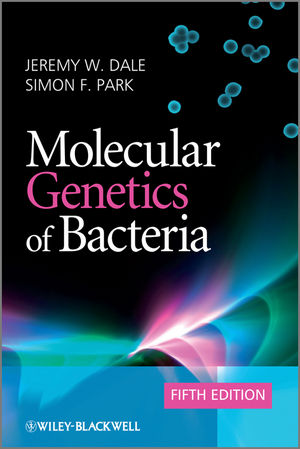Molecular Genetics of Bacteria, 5th EditionISBN: 978-0-470-74185-6
Hardcover
402 pages
May 2010
 This is a Print-on-Demand title. It will be printed specifically to fill your order. Please allow an additional 10-15 days delivery time. The book is not returnable.
Other Available Formats: Paperback
|
||||||
1 Nucleic Acid Structure and Function.
1.1 Structure of nucleic acids.
1.1.1 DNA.
1.1.2 RNA.
1.1.3 Hydrophobic interactions.
1.1.4 Different forms of the double helix.
1.1.5 Supercoiling.
1.1.6 Denaturation and hybridization.
1.1.7 Orientation of nucleic acid strands.
1.2 Replication of DNA.
1.2.1 Unwinding and rewinding.
1.2.2 Fidelity of replication; proofreading.
1.3 Chromosome replication and cell division.
1.4 DNA repair.
1.4.1 Mismatch repair.
1.4.2 Excision repair.
1.4.3 Recombination (post-replication) repair.
1.4.4 SOS repair.
1.5 Gene expression.
1.5.1 Transcription.
1.5.2 Translation.
1.5.3 Post-translational events.
1.6 Gene organization.
2 Mutation and Variation.
2.1 Variation and evolution.
2.1.1 Fluctuation test.
2.1.2 Replica plating.
2.1.3 Directed mutation in bacteria?
2.2 Types of mutation.
2.2.1 Point mutations.
2.2.2 Conditional mutants.
2.2.3 Variation due to larger-scale DNA alterations.
2.2.4 Extrachromosomal agents and horizontal gene transfer.
2.3 Recombination.
2.3.1 A model of the general (homologous) recombination process.
2.3.2 Enzymes involved in recombination.
2.4 Phenotypes.
2.4.1 Restoration of phenotype.
2.5 Mechanisms of mutation.
2.5.1 Spontaneous mutation.
2.5.2 Chemical mutagens.
2.5.3 Ultraviolet irradiation.
2.6 Isolation and identification of mutants.
2.6.1 Mutation and selection.
2.6.2 Replica plating.
2.6.3 Isolation of other mutants.
2.6.4 Molecular methods.
3 Regulation of Gene Expression.
3.1 Gene copy number.
3.2 Transcriptional control.
3.2.1 Promoters.
3.2.2 Terminators, attenuators and anti-terminators.
3.2.3 Induction and repression: regulatory proteins.
3.2.4 Two-component regulatory systems.
3.2.5 Global regulatory systems.
3.2.6 Quorum sensing.
3.3 Translational control.
3.3.1 Ribosome binding.
3.3.2 Codon usage.
3.3.3 Stringent response.
3.3.4 Regulatory RNA.
3.4 Phase variation.
4 Genetics of Bacteriophages.
4.1 Bacteriophage structure.
4.2 Single-strand DNA bacteriophages.
4.2.1 ϕX174.
4.2.2 M13.
4.3 RNA-containing phages: MS2.
4.4 Double-stranded DNA phages.
4.4.1 Bacteriophage T4.
4.4.2 Bacteriophage λ.
4.4.3 Lytic and lysogenic regulation of bacteriophage λ.
4.5 Restriction and modification.
4.6 Bacterial resistance to phage attack.
4.7 Complementation and recombination.
4.8 Why are bacteriophages important?
4.8.1 Phage typing.
4.8.2 Phage therapy.
4.8.3 Phage display.
4.8.4 Phages in the natural environment.
4.8.5 Bacterial virulence and phage conversion.
5 Plasmids.
5.1 Some bacterial characteristics are determined by plasmids.
5.1.1 Antibiotic resistance.
5.1.2 Colicins and bacteriocins.
5.1.3 Virulence determinants.
5.1.4 Plasmids in plant-associated bacteria.
5.1.5 Metabolic activities.
5.2 Molecular properties of plasmids.
5.2.1 Plasmid replication and control.
5.2.2 Partitioning.
5.2.3 Host range.
5.2.4 Plasmid incompatibility.
5.3 Plasmid stability.
5.3.1 Plasmid integrity.
5.3.2 Partitioning.
5.3.3 Differential growth rate.
5.4 Associating a plasmid with a phenotype.
6 Gene Transfer.
6.1 Transformation.
6.2 Conjugation.
6.2.1 Mechanism of conjugation.
6.2.2 The F plasmid.
6.2.3 Conjugation in other bacteria.
6.3 Transduction.
6.3.1 Specialized transduction.
6.4 Recombination.
6.4.1 Consequences of recombination.
6.4.2 Site-specific and non-homologous (illegitimate) recombination.
6.5 Mosaic genes and chromosome plasticity.
7 Genomic Plasticity: Movable Genes and Phase Variation.
7.1 Insertion sequences.
7.1.1 Structure of insertion sequences.
7.1.2 Occurrence of insertion sequences.
7.2 Transposons.
7.2.1 Structure of transposons.
7.2.2 Integrons.
7.2.3 ISCR elements.
7.3 Mechanisms of transposition.
7.3.1 Replicative transposition.
7.3.2 Non-replicative (conservative) transposition.
7.3.3 Regulation of transposition.
7.3.4 Activation of genes by transposable elements.
7.3.5 Mu: A transposable bacteriophage.
7.3.6 Conjugative transposons.
7.4 Phase variation.
7.4.1 Variation mediated by simple DNA inversion.
7.4.2 Variation mediated by nested DNA inversion.
7.4.3 Antigenic variation in the gonococcus.
7.4.4 Phase variation by slipped-strand mispairing.
7.4.5 Phase variation mediated by differential DNA methylation.
7.5 Clustered regularly interspersed short palindromic repeats.
8 Genetic Modification: Exploiting the Potential of Bacteria.
8.1 Strain development.
8.1.1 Generation of variation.
8.1.2 Selection of desired variants.
8.2 Overproduction of primary metabolites.
8.2.1 Simple pathways.
8.2.2 Branched pathways.
8.3 Overproduction of secondary metabolites.
8.4 Gene cloning.
8.4.1 Cutting and joining DNA.
8.4.2 Plasmid vectors.
8.4.3 Bacteriophage λ vectors.
8.4.4 Cloning larger fragments.
8.4.5 Bacteriophage M13 vectors.
8.5 Gene libraries.
8.5.1 Construction of genomic libraries.
8.5.2 Screening a gene library.
8.5.3 Cloning PCR products.
8.5.4 Construction of a cDNA library.
8.6 Products from cloned genes.
8.6.1 Expression vectors.
8.6.2 Making new genes.
8.6.3 Other bacterial hosts.
8.6.4 Novel vaccines.
8.7 Other uses of gene technology.
9 Genetic Methods for Investigating Bacteria.
9.1 Metabolic pathways.
9.1.1 Complementation.
9.1.2 Cross-feeding.
9.2 Microbial physiology.
9.2.1 Reporter genes.
9.2.2 Chromatin immunoprecipitation.
9.2.3 Cell division.
9.2.4 Motility and chemotaxis.
9.2.5 Cell differentiation.
9.3 Bacterial virulence.
9.3.1 Wide-range mechanisms of bacterial pathogenesis.
9.3.2 Detection of virulence genes.
9.4 Specific mutagenesis.
9.4.1 Gene replacement.
9.4.2 Antisense RNA.
9.5 Taxonomy, evolution and epidemiology.
9.5.1 Molecular taxonomy.
9.5.2 GC content.
9.5.3 16 S rRNA.
9.5.4 Denaturing-gradient gel electrophoresis and temperature-gradient gel electrophoresis.
9.5.5 Diagnostic use of PCR.
9.5.6 Molecular epidemiology.
10 Gene Mapping to Genomics and Beyond.
10.1 Gene mapping.
10.1.1 Conjugational analysis.
10.1.2 Gene libraries.
10.1.3 Restriction mapping and pulsed-field gel electrophoresis.
10.2 DNA sequence determination.
10.2.1 Sanger sequencing.
10.2.2 Dye terminator sequencing.
10.2.3 Pyrosequencing.
10.2.4 Massively parallel sequencing.
10.3 Genome sequencing.
10.3.1 Genome-sequencing strategies.
10.3.2 Relating sequence to function.
10.3.3 Metagenomics.
10.4 Comparative genomics.
10.4.1 Microarrays.
10.5 Analysis of gene expression.
10.5.1 Transcriptional analysis.
10.5.2 Translational analysis.
10.6 Metabolomics.
10.7 Systems biology and synthetic genomics.
10.7.1 Systems biology.
10.7.2 Synthetic genomics.
10.8 Conclusion.
Appendix A Further Reading.
Appendix B Abbreviations Used.
Appendix C Glossary.
Appendix D Enzymes and other Proteins.
Appendix E Genes.
Appendix F Standard Genetic Code.
Appendix G Bacterial Species.
Index.



